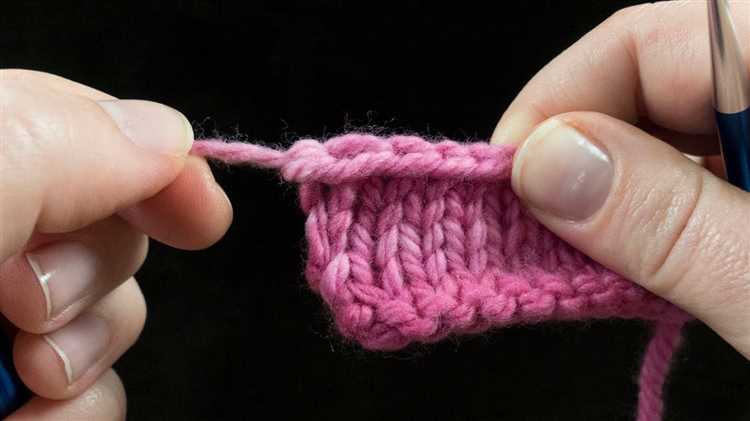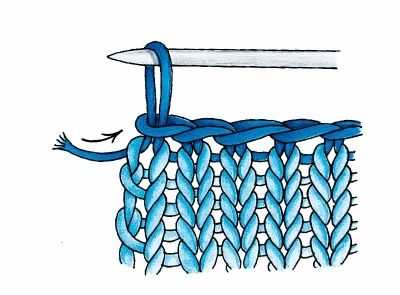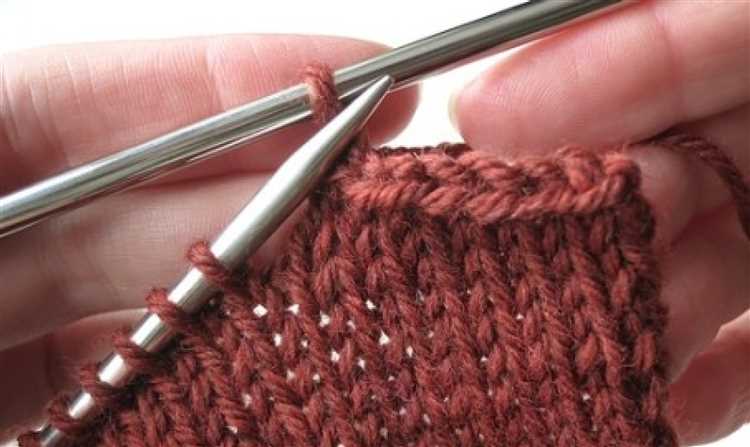Binding off, also known as casting off, is the final step in knitting a project. It is the process of taking the live stitches off the needles in a neat and secure manner, creating a finished edge. Knowing how to bind off stitches is an essential skill for every knitter, as it allows you to complete your projects and give them a professional look.
There are various methods to bind off stitches, each yielding a slightly different result. In this tutorial, we will guide you through the basic method that is commonly used for most knitting projects. It is a simple and versatile technique that can be easily adapted to different stitch patterns and project types.
To bind off stitches, you will need a pair of knitting needles and a yarn needle. The basic process involves knitting two stitches, then passing the first stitch over the second stitch and off the needle. This creates a new stitch with each repetition. As you work your way across the row, the number of stitches on your needle decreases until you are left with only one stitch. Finally, you cut the yarn and pull it through the last stitch, securing it in place.
Note: It’s important to maintain an even tension as you bind off, as a tight bind off can cause the edge to pucker and a loose bind off can result in a sloppy finish. Practice and experimentation will help you find the right tension for your projects.
By mastering the art of binding off, you will be able to confidently complete your knitting projects and achieve a polished finish. So grab your knitting needles and let’s get started!
Understanding the Importance of Binding Off
Binding off is the final step in knitting a project, and it is essential for finishing your work and ensuring its longevity. It involves securing the stitches on your needle so that they do not unravel or come undone. Binding off creates a neat edge on your knitted fabric and gives your project a polished and professional look.
Here are several reasons why binding off is important:
- Prevents unraveling: When you bind off, you create a secure edge that prevents the stitches from unraveling. This is particularly important for garments, accessories, or any knitted item that will be subject to wear and tear.
- Creates a finished look: Binding off provides a clean and neat edge to your project, making it look complete. It defines the shape of your project and adds a level of professionalism to your knitting.
- Allows for blocking: Binding off is a necessary step before blocking your knitted piece. Blocking involves shaping and stretching the fabric to ensure that it is the correct size and shape. Binding off beforehand helps maintain the shape of your project during blocking.
- Enables joining: Binding off is often required when joining different pieces of a project, such as when seaming sleeves or attaching a collar. It provides a stable edge that can easily be sewn or joined to another piece.
- Prevents dropped stitches: Binding off can help prevent dropped stitches, especially along the edges of your project. By securing the stitches, you decrease the chances of accidentally dropping a stitch and potentially unraveling your work.
It is essential to understand and practice different bind-off techniques to ensure the best results for your knitting projects. There are various bind-off methods available, each with its own characteristics and uses. By mastering these techniques, you can achieve the desired finishing touches and create beautiful, lasting knitted items.
| Method | Description |
|---|---|
| Standard Bind-Off | A basic bind-off method that creates a firm edge. |
| Elastic Bind-Off | A stretchy bind-off method suitable for cuffs and edges that need a bit more give. |
| I-Cord Bind-Off | An attractive decorative bind-off that creates a cord-like edge. |
| Three-Needle Bind-Off | A method for joining two sets of live stitches together. |
Learning the Basic Technique of Binding Off
Binding off is the final step in completing a knitted project. It is a technique used to secure the stitches and prevent them from unraveling. By binding off, you can create a finished edge on your project.
To bind off stitches, follow these simple steps:
- Start by knitting the first two stitches.
- Insert the left needle into the first stitch on the right needle.
- Lift the first stitch over the second stitch and off the right needle.
- Knit the next stitch.
- Repeat steps 2-4 until you have one stitch left on the right needle.
- Cut the yarn, leaving a tail that is at least 6 inches long.
- Thread the tail through the last stitch and pull tight to secure.
Once you have bound off all your stitches, you can weave in the loose ends of yarn to further secure the edge and give your project a polished look.
Binding off is an essential skill in knitting and is used in many different projects, such as scarves, hats, and sweaters. With practice, you will be able to bind off confidently and create beautiful finished edges on your knitted items.
Step-by-Step Guide to Binding Off Stitches
Binding off, also known as casting off, is the final step in completing your knitting project. It creates a neat edge and prevents your stitches from unraveling. Follow these simple steps to bind off stitches:
- Start with the last row of stitches on your left needle.
- Knit the first two stitches on your left needle.
- Using your left needle, lift the first stitch over the second stitch and off the right needle. This creates one bound off stitch.
- Knit the next stitch on your left needle.
- Lift the first stitch over the second stitch and off the right needle again.
- Continue knitting one stitch and lifting the previous stitch over it until you have bound off all the stitches.
- Once you have bound off all the stitches, cut the yarn, leaving a long tail.
- Thread the tail through the last stitch and pull tight to secure.
In some projects, you may need to use a different bind off method to achieve a specific edge. There are various bind off methods, such as the stretchy bind off, picot bind off, or tubular bind off. These methods are used in different knitting patterns and can be learned and practiced as you gain more experience in knitting.
Different Methods of Binding Off
When it comes to binding off stitches in knitting, there are several different methods you can choose from. Each method produces a slightly different edge, so it’s worth experimenting to find the one that works best for your specific project. Here are a few popular options:
- Standard Bind Off: This is the most common method of binding off. It creates a stable edge and is easy to do. Simply knit the first two stitches, then insert the left needle into the first stitch on the right needle and lift it over the second stitch and off the needle. Repeat this process until all stitches are bound off.
- Stretchy Bind Off: If you want a more flexible edge, the stretchy bind off is a good choice. It is ideal for projects like socks or cuffs that need to stretch over a wider area. To do this bind off, use a larger needle size and knit the first two stitches. Then insert the left needle into the first stitch on the right needle, knit it, and slip both stitches off. Repeat this process until all stitches are bound off.
- I-Cord Bind Off: The I-cord bind off creates a decorative and professional-looking edge. To do this bind off, cast on 3 stitches onto a double-pointed needle. *Knit the first 2 stitches, then slip the third stitch purlwise to the right needle. Bring the yarn to the back, knit the next stitch, and repeat from * until all stitches are bound off.
- Lace Bind Off: If you’re working on a lacy project, such as a shawl or scarf, the lace bind off can be a good choice. It creates a delicate and decorative edge that complements the lace pattern. To do this bind off, work the stitches as indicated in the lace pattern, incorporating decreases and yarn overs as needed to maintain the pattern.
These are just a few examples of the many ways to bind off stitches in knitting. Each method has its pros and cons, so it’s worth experimenting with different options to find the one that achieves the desired result for your project.
Troubleshooting Common Issues in Binding Off
Binding off is the process of finishing a knitted piece by securely closing the live stitches. While it may seem straightforward, there are some common issues that knitters may encounter when binding off. Here are some troubleshooting tips to help you overcome these issues:
1. Loose or Uneven Stitches
If your bound off edge looks loose or uneven, it may be due to inconsistent tension while working the bind off stitches. To ensure a neater and more even edge, try the following:
- Focus on maintaining a consistent tension as you work each bind off stitch.
- Use a smaller needle size for the bind off stitches to create a tighter edge.
- If you find that your stitches are still loose, you can try binding off more tightly by pulling the yarn a little tighter after each stitch.
2. Tight or Restrictive Edge
If your bound off edge feels too tight or restrictive, it may be because you are pulling the yarn too tightly as you work the bind off stitches. To create a looser edge, try the following:
- Loosen your tension and allow more yarn to flow through each stitch as you bind off.
- Use a larger needle size for the bind off stitches to create a looser edge.
- If you are using a non-elastic yarn, consider switching to a stretchier yarn for the bind off to allow for more flexibility.
3. Curling or Rolling Edge
If your bound off edge is curling or rolling, it may be due to the nature of the stitch pattern or the type of yarn used. To prevent this, you can try the following:
- Choose a bind off method that adds some elasticity to the edge, such as the stretchy bind off or the picot bind off.
- Block your knitted piece to help relax the stitches and encourage them to lay flat.
- Consider using a different stitch pattern that creates a more stable edge, such as a garter stitch or a ribbing pattern.
4. Knots or Lumps in the Edge
If you notice knots or lumps in your bound off edge, it may be due to accidental yarn overs or extra loops. To avoid this, pay attention to the following:
- Make sure to work each bind off stitch separately without accidentally adding extra yarn overs.
- Count your stitches regularly to ensure that you have the correct number of stitches on your right-hand needle.
- If you do encounter knots or lumps, carefully undo the bind off stitches and fix any mistakes before proceeding.
By troubleshooting these common issues, you can achieve a professional and polished finish to your knitting projects. Remember to practice and experiment with different techniques to find the method that works best for you.
Tips and Tricks for a Neat and Professional Binding Off
Binding off is the final step in knitting a project and it’s important to do it properly to achieve a neat and professional finish. Here are some tips and tricks to help you master the art of binding off:
- Choose the right needle size: When binding off, it’s important to use a needle that is one or two sizes larger than the one you used for knitting the project. This will ensure that your bound off edge is not too tight and allows for a nice drape.
- Keep your tension consistent: To ensure an even and professional-looking bind off, it’s crucial to maintain consistent tension throughout. Avoid pulling the yarn too tightly or leaving it too loose. Practice maintaining the same tension as you work through the bind off stitches.
- Slip the first stitch: For a neater edge, try slipping the first stitch purlwise knitwise with the yarn in front on every row. This creates a smooth edge and prevents the bound off edge from curling.
- Use a stretchy bind off for ribbing: When binding off ribbed stitches, such as those used for cuffs or collars, it’s important to use a stretchy bind off method to allow for proper elasticity. The Jeny’s Surprisingly Stretchy Bind Off is a popular method for this.
- Consider a decorative bind off: Depending on the project, you may want to add a decorative touch to your bind off. There are various decorative bind off techniques that can add flair to the edge of your knitting, such as picot bind off or lace bind off.
- Block your finished project: Blocking your project after binding off can help to even out any uneven stitches and give your project a polished look. Follow the blocking instructions for your specific type of yarn and project.
Remember, practice makes perfect when it comes to binding off. Experiment with different techniques and find the method that works best for you and your project. With time and experience, your binding off skills will improve, and you’ll be able to achieve a beautiful and professional finish every time.
Advanced Techniques in Binding Off for Different Knitting Projects
Once you have learned the basic technique of binding off stitches in knitting, you can advance your skills by exploring different methods that can enhance the finish and appearance of your knitting projects. These advanced techniques can be used to create various decorative edges, add elasticity to cuffs, or achieve specific effects for different types of projects.
Here are some advanced binding off techniques that you can experiment with:
-
Elastic Bind Off:
This technique adds elasticity to the edge of your knitting project, making it ideal for cuffs, hats, or any other garment that needs a stretchy edge. To achieve this, you can use a larger needle size or try the Jeny’s Surprisingly Stretchy Bind Off method, which involves a combination of knitting and yarn overs to create a stretchy edge.
-
Decorative Bind Off:
If you want to add a decorative touch to the edge of your knitting project, you can explore various bind off patterns such as picot bind off, picot edge bind off, or eyelet bind off. These techniques involve creating eyelets or loops at regular intervals to achieve a decorative effect. You can find detailed instructions for these techniques in knitting pattern books or online resources.
-
Provisional Bind Off:
A provisional bind off is a temporary bind off that allows you to pick up the live stitches later for further knitting. This technique is often used when you need to create a seamless edge or when you want to add a border or go back and change the design of your project. To achieve a provisional bind off, you can use a waste yarn or a separate knitting needle.
-
I-Cord Bind Off:
The I-cord bind off method creates a small, decorative tube-like edge which is perfect for finishing cuffs, edges of blankets, or any other project that needs a polished, rounded edge. This technique involves knitting a few stitches, then sliding them back to the beginning of the right-hand needle and repeating the process until all stitches are bound off.
These are just a few examples of advanced binding off techniques that you can explore to enhance your knitting projects. Each technique has its own unique purpose and effect, so feel free to experiment and find the one that works best for your specific project. Remember, practice makes perfect, so don’t be afraid to try new techniques and make mistakes along the way. Happy knitting!
FAQ:
What does it mean to bind off stitches in knitting?
Binding off stitches in knitting is the process of finishing a piece by securely closing the stitches and creating an edge that won’t unravel.
Why is it important to bind off stitches?
Binding off stitches is important because it gives a polished and finished look to the knitted piece. It also ensures that the stitches won’t unravel over time.
Are there any different methods for binding off stitches?
Yes, there are different methods for binding off stitches in knitting. Some common methods include the basic bind off, the picot bind off, and the stretchy bind off. Each method creates a slightly different edge and has its own unique instructions.
What is the basic bind off method?
The basic bind off method is the most common way to bind off stitches in knitting. It involves knitting two stitches, then passing the first stitch over the second stitch and completely off the needle. Repeat this process until all stitches have been bound off.


